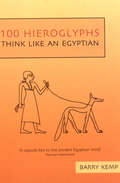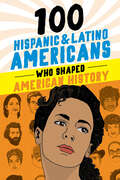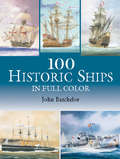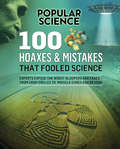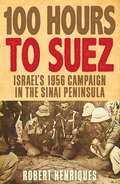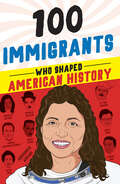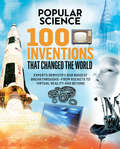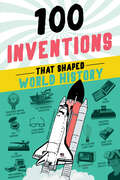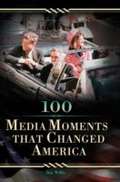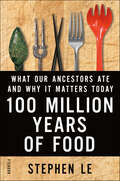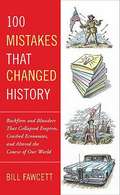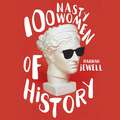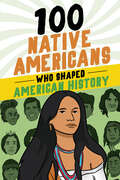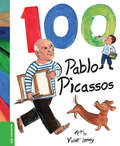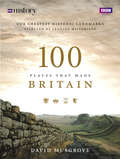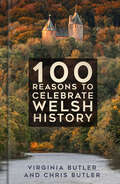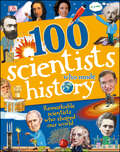- Table View
- List View
100 Hieroglyphs: Think Like an Egyptian
by Barry Kemp&“Written by the greatest living Egyptologist, this wonderful, fun, and short book will take you inside the heads of the ancient Egyptians.&”—Sarah Parcak, National Geographic Egyptian culture is divided from us by several millennia, a lost people and a dead language. We can discover much about this fascinating civilization from its physical remains, but perhaps the greatest insights into the Egyptian mind come from Egyptian hieroglyphs. They reveal the priorities, concerns and beliefs of the Egyptians—a whole worldview. Unlike the Western alphabet, which is an arbitrary set of symbols not anchored in reality, each Egyptian hieroglyph denotes a concept central to Egyptian thinking. The language and its written form are intimately bound up with the imaginative world of the Egyptians. Here, Barry Kemp presents 100 of the Egyptian hieroglyphs to provide access to this unique culture. Kemp takes us on a journey through the Egyptian mind, revealing not only aspects of day-to-day life in Ancient Egypt, but gradually building a picture of the historical and mythological references that were the cornerstones of Egyptian thought. This fascinating book helps us get inside a long-vanished world. &“A capsule key to the ancient Egyptian mind.&”—Dr. Norman Hammond, The Times &“Kemp uses 100 hieroglyphs as a springboard for discussion of a range of topics . . . This clever premise works well . . . [an] enjoyable and informative volume.&”—Times Higher Education Supplement &“This is most certainly a book that will challenge and reward.&”—New World
100 Hispanic and Latino Americans Who Shaped American History (100 Series)
by Rick LaezmanLearn all about the fascinating lives and tremendous impact of 100 extraordinary Hispanic and Latino Americans with this fact-filled biography collection for kids. Educational and engaging, 100 Hispanic and Latino Americans Who Shaped American History features:Simple, easy-to-read text that has been freshly updated and now includes brand-new additions of Gloria E. Anzaldúa and Justice Sonia SotomayorIllustrated portraits of each figureFascinating facts about famous and lesser-known Hispanic American heroesA timeline, trivia questions, project ideas and more!From Mariano Vallejo to Carmen Miranda, Cesar Chavez to Oscar de la Renta, Aliza Lifshitz to Sandra Cisneros and many more, readers will be introduced to artists, activists, scientists, and icons throughout history. Organized chronologically, 100 Hispanic and Latino Americans Who Shaped American History offers a look at the prominent role these men and women played and how their talents, ideas, and expertise have influenced the country from its very beginning all the way through the present day.
100 Historic Ships in Full Color
by John BatchelorThis collection of magnificent original full-color paintings accurately depicts 100 amazing ships -- from the royal barge of the Egyptian pharaoh Cheops (2657 B.C.) and the Viking ships that visited North America around A.D. 1001 to Columbus' flagship, the Santa Maria (1492), and the nuclear submarine U.S.S. Seawolf. 100 illustrations in full color.
100 Hoaxes & Mistakes That Fooled Science (Popular Science)
by The Editors of Popular ScienceEven experts get duped from time to time! The stories behind scientific fakes and mistakes, from crop circles to miracle cures and beyond. Science is an ongoing quest for knowledge filled with discoveries and experiments, trial and error. And occasionally, the errors can be whoppers—especially when hoaxers are involved. Some hoaxes are intended merely as well-intended humorous tricks, while others are serious frauds devised for personal gain of glory and riches. This book reveals the greatest science hoaxes and mistakes of all time. Discover the truth behind 100 of the most scandalous scientific errors and outright lies in this fascinating read brought to you by Popular Science—from the experiment that suggested time travel was possible, to the pursuit of alchemy, to rumors about red mercury and its mythical powers, it&’s an entertaining journey through the history of science.
100 Hours to Suez
by Robert Henriques100 Hours to Suez, first published in 1957, is a firsthand account of Israel's invasion of Egypt's Sinai Peninsula in late 1956. Included are 3 pages of maps. Author Robert Henriques (1905-1967) was a British writer, broadcaster, and farmer. During World War II he served in the British Army as well as with the American army, and, as he states in 100 Hours to Suez “during World War II, I spent much of my time serving with United States forces; I landed with United States assault troops at both Casablanca and Sicily; on occasion I have worn the American uniform with pride; I served with General Patton in North Africa; I was twice given medals by President Roosevelt in reward for my services under General Eisenhower.”
100 Immigrants Who Shaped American History (100 Series)
by Joanne MatternIncredible stories of 100 extraordinary American immigrants, for kids 8 and upThis easy-to-read biography collection includes:100 one-page biographies: Find out how these incredible individuals changed the course of history!Illustrated portraits: Each biography includes an illustration to help bring history to life!A timeline, trivia questions, project ideas, and more: Boost your learning and test your knowledge with fun activities and resources!From Alexander Graham Bell to Albert Einstein, Mary Pickford to Alfred Hitchcock, Hannah Arendt to Madeleine Albright and many more, readers will be introduced to artists, activists, scientists, and icons throughout history who made America their home. Organized chronologically, 100 Immigrants Who Shaped American History offers a look at the prominent role immigrants have always played in America and how their talents, ideas, and expertise have guided the country from its very beginning all the way through the present day.
100 Inventions That Changed the World (Popular Science)
by The Editors of Popular ScienceFrom safety pins to steam engines to cell phones, the stories behind innovations that have transformed everyday lives. We take thousands of inventions for granted, using them daily and enjoying their benefits. But how much do we really know about their origins and development? This absorbing new book tells the stories behind the inventions that have changed the world, with details about: Convenience items, such as safety pins, toothbrushes, and bifocals Weapons of war, including explosives, gunpowder, and shrapnel shells Industrial advances, such as the steam engine and the power loom for weaving Transportation advances, including the airplane, the diesel engine, the automobile, and the air-inflated rubber tire Electronic marvels, including color television, the microprocessor, the personal computer, the compact disc, and the cell phone Medical advances, from antiseptic surgery to the electron microscope...and much more You&’ll also learn more about many inventors and pioneers of science and technology—including Eli Whitney, James Watt, Benjamin Franklin, Henry Bessemer, Thomas Edison, J.B. Dunlop, the Wright Brothers, Werner von Braun, Jonas Salk, J. Robert Oppenheimer, and others.
100 Inventions That Shaped World History (100 Series)
by Bill YenneFascinating stories behind 100 of the most important inventions in history, for kids 8 and upThis fast-paced journey through the most vital developments and inventions of all time features:100 easy-to-read stories: Find out how each invention came to be!Illustrations: Each entry includes an illustrated image of the invention to help bring history to life!A timeline, trivia questions, project ideas and more: Boost your learning and test your knowledge with fun activities and resources!From the compass to the printing press, television to virtual reality, readers will learn about 100 of the most important inventions, advancements, and discoveries that have changed the course of human history. Organized chronologically, this fast-paced journey through the history of technology will help kids understand how their favorite modern conveniences came to be.
100 Jahre Türkei – 100 Köpfe: Biografische Skizzen zu Gegenwart und Geschichte der türkischen Republik 1923-2023 (Politik, Wirtschaft und Gesellschaft im Spannungsverhältnis der Regionen Südosteuropa und Mittlerer Osten)
by Wolfgang GielerZum 100-jährigen Jubiläum der Gründung der türkischen Republik am 29. Oktober 2023 werden 100 Personen aus der Türkei vorgestellt, die nicht nur die Politik, sondern auch die Wirtschaft, Wissenschaft, Gesellschaft und Kultur des Landes entscheidend charakterisiert und beeinflusst haben.Neben ehemaligen und aktuellen Politiker*innen, Staats- und Regierungschef*innen, Außenminister*innen werden insbesondere auch Schriftsteller*innen, Wissenschaftler*innen, Künstler*innen, Musiker*innen, Designer*innen, Sportler*innen anhand ihrer Biografien behandelt und in den jeweiligen zeithistorischen Kontext gestellt. Der Band ist um ein erweitertes Verständnis der Türkei bemüht. Wesentlicher Beweggrund des Autors – der 15 Jahre an verschiedenen türkischen Universitäten gelehrt hat - ist hierbei eine zumeist fehlende Auseinandersetzung mit den in der Türkei handelnden Personen anzuregen und damit die Türkei auch besser zu verstehen.
100 Maple Leaf Moments
by Bob DuffIn a century of Toronto Maple Leafs hockey, there’s been greatness, awful times, some anecdotes that will always be remembered, others that can’t be forgotten, and some that defy belief. They’re all worth reading and sharing - and they’re all here.
100 Media Moments That Changed America
by Jim WillisFrom the launching of America's first newspaper to YouTube's latest phone-videoed crime, the media has always been guilty of indulging America's obsession with controversy. This encyclopedia covers 100 events in world history from the 17th century to the present--moments that alone were major and minor, but ones that exploded in the public eye when the media stepped in. Topics covered include yellow journalism, the War of the Worlds radio broadcast, the Kennedy-Nixon debates, JFK's assassination, the Pentagon papers, and Hurricane Katrina. These are events that changed the way the media is used-not just as a tool for spreading knowledge, but as a way of shaping and influencing the opinions and reactions of America's citizens. Thanks to the media's representations of these events, history has been changed forever. From classified military plans that leaked out to the public to the first televised presidential debates to the current military tortures caught on tape, Breaking News will demonstrate not only an ever-evolving system of news reporting, but also the ways in which historical events have ignited the media to mold news in a way that resonates with America's public. This must-have reference work is ideal for journalism and history majors, as well as for interested general readers.Chapters are in chronological order, beginning with the 17th century. Each chapter starts with a brief introduction, followed by media event entries from that decade. Each entry explains the moment, and then delivers specific details regarding how the media covered the event, America's response to the coverage, and how the media changed history.
100 Military Inventions that Changed the World: That Changed The World
by Philip RussellNothing ensures the rapid development of new technology like the involvement of the military. From the trebuchet and the cannon to the tank and the ballistic missile, military research programmes have produced the most devastating weapons imaginable, but military masterminds are responsible for a number of surprises along the way as well.Radar, walkie-talkies and the jet engine are more obvious examples of military inventions that are now in everyday use around the world, but there are plenty of items with which all of us come into contact on a daily basis that have been developed from military technology. Rod Green describes how the microwave oven in your kitchen, the sat-nav in your car or the Internet that you use every day all owe their existence to the military as he takes us on a highly entertaining voyage of discovery through the world of military inventions ancient and modern.
100 Military Inventions that Changed the World: That Changed The World
by Rod GreenNothing ensures the rapid development of new technology like the involvement of the military. <P><P>From the trebuchet and the cannon to the tank and the ballistic missile, military research programmes have produced the most devastating weapons imaginable, but military masterminds are responsible for a number of surprises along the way as well. Radar, walkie-talkies and the jet engine are more obvious examples of military inventions that are now in everyday use around the world, but there are plenty of items with which all of us come into contact on a daily basis that have been developed from military technology.<P>Rod Green describes how the microwave oven in your kitchen, the sat-nav in your car or the Internet that you use every day all owe their existence to the military as he takes us on a highly entertaining voyage of discovery through the world of military inventions ancient and modern.
100 Million Years of Food: What Our Ancestors Ate and Why It Matters Today
by Stephen LeA fascinating tour through the evolution of the human diet and how we can improve our health by understanding our complicated history with food.There are few areas of modern life that are burdened by as much information and advice, often contradictory, as our diet and health: eat a lot of meat, eat no meat; whole grains are healthy, whole grains are a disaster; eat everything in moderation; eat only certain foods--and on and on. In 100 Million Years of Food, biological anthropologist Stephen Le explains how cuisines of different cultures are a result of centuries of evolution, finely tuned to our biology and surroundings.Today many cultures have strayed from their ancestral diets, relying instead on mass-produced food often made with chemicals that may be contributing to a rise in so-called Western diseases, such as cancer, heart disease, and obesity.
100 Mistakes that Changed History
by Bill FawcettCollected in one volume, here are backfires and blunders that collapsed empires, crashed economies, and altered the course of the world. From the Maginot Line to the Cuban Missile Crisis, history is filled with bad moves and not-so-bright ideas that snowballed into disasters and unintended consequences. This engrossing book looks at one hundred such tipping points. Japan bombs Pearl Harbor. The Caliphs of Baghdad spend themselves into bankruptcy. The Aztecs greet the Conquistadors with open arms. Mexico invites the Americans to Texas-and the Americans never leave. And the rest is history...
100 More Canadian Heroines: Famous and Forgotten Faces
by Merna Forster Julie PayetteFollowing the bestselling 100 Canadian Heroines, Merna Forster presents 100 more stories of amazing women who changed our country. In this second installment of the bestselling Canadian Heroines series, author Merna Forster brings together 100 more incredible stories of great characters and wonderful images. Meet famous and forgotten women in fields such as science, sport, politics, war and peace, and arts and entertainment, including the original Degrassi kids, Captain Kool, hockey star Hilda Ranscombe, and the woman dubbed "the atomic mosquito." This book is full of amazing facts and trivia about extraordinary women. You’ll learn about Second World War heroine Joan Fletcher Bamford, who rescued 2,000 Dutch captives from a prison camp in a Sumatran jungle while commanding 70 Japanese soldiers. Hilwie Hamdon was the woman behind the building of Canada’s first mosque, and Frances Gertrude McGill was the crime fighter named the "Sherlock Holmes of Saskatchewan." Read on and discover 100 more Canadian heroines and how they’ve changed our country.
100 Nasty Women of History: Brilliant, badass and completely fearless women everyone should know
by Hannah Jewell'Vital reading' STYLIST'...hooting with laughter - what a swashbuckler that Hannah Jewell is' MARINA HYDE'Because 100 Nasty Women is so easy to read and witty, I didn't expect it to be the life changing, important book that I'm discovering it to be' PHILIPPA PERRY'A fantastic addition to your feminist library and historical knowledge.' ANN SHEN, author of Bad Girls Throughout History* * * * * *100 fascinating and brilliantly written stories about history's bravest, baddest but little known 'nasty' women from across the world.These are the women who were deemed too nasty for their times, too nasty to be recognised, too nasty to be paid for their work and sometimes too nasty to be allowed to live. When you learn about women in history, they're often made out to be shining, glittering souls. But when you hear about these Bold-Yet-Morally-Irreproachable Women of History who were 100% Pure and Good™, you're probably not being told the best bits of her life. You probably missed the part where she:Slept aroundWore men's clothesCrashed planesLed a revolutionTerrorised the seven seasWrote ~sensual poetry~Punched a Nazi (metaphorically, but not always)These are the women you've probably never heard of, but should. Take these stories and tell them to your friends, because everyone should know about the nasty women from history who gave zero f*cks whatsoever. These are the 100 Nasty Women of History you need to know about.
100 Nasty Women of History: Brilliant, badass and completely fearless women everyone should know
by Hannah Jewell'Vital reading' STYLIST'...hooting with laughter - what a swashbuckler that Hannah Jewell is' MARINA HYDE'Because 100 Nasty Women is so easy to read and witty, I didn't expect it to be the life changing, important book that I'm discovering it to be' PHILIPPA PERRY'A fantastic addition to your feminist library and historical knowledge.' ANN SHEN, author of Bad Girls Throughout History* * * * * *100 fascinating and brilliantly written stories about history's bravest, baddest but little known 'nasty' women from across the world.These are the women who were deemed too nasty for their times, too nasty to be recognised, too nasty to be paid for their work and sometimes too nasty to be allowed to live. When you learn about women in history, they're often made out to be shining, glittering souls. But when you hear about these Bold-Yet-Morally-Irreproachable Women of History who were 100% Pure and Good™, you're probably not being told the best bits of her life. You probably missed the part where she:Slept aroundWore men's clothesCrashed planesLed a revolutionTerrorised the seven seasWrote ~sensual poetry~Punched a Nazi (metaphorically, but not always)These are the women you've probably never heard of, but should. Take these stories and tell them to your friends, because everyone should know about the nasty women from history who gave zero f*cks whatsoever. These are the 100 Nasty Women of History you need to know about.
100 Nasty Women of History: Brilliant, badass and completely fearless women everyone should know
by Hannah Jewell100 fascinating and brilliantly written stories about history's bravest, baddest but little known 'nasty' women from across the world.In the final debate of the 2016 US presidential election, Donald Trump leaned into the microphone as Hillary Clinton spoke about social security and called his opponent 'such a nasty woman'. The phrase has stuck around and has since become something of a badge of honour for women around the world. What better time than now, then, for us to look back and learn a thing or two from the 'nasty' women of the past? Compiled and written by BuzzFeed writer Hannah Jewell, 100 Nasty Women of History contains profiles of women from across every century, race and continent, united in the fact that they were all a bit 'nasty'. From 3rd-century Japanese Empress Jingu to 20th-century British social reformer Octavia Hill, these are the women who were bold and powerful, but maybe put people (men's) backs up by being so. 100 Nasty Women of History is an accessible, intelligent, hilarious (and sometimes sweary) guide to the history-making women whom you probably don't know - but definitely should.(P)2017 Hodder & Stoughton Limited
100 Native Americans Who Shaped American History (100 Series)
by Bonnie JuettnerLearn all about the fascinating lives and tremendous impact of 100 extraordinary Native Americans with this fact-filled biography collection for kids. Educational and engaging, 100 Native Americans Who Shaped American History features:Simple, easy-to-read text that has been freshly updated and now includes brand-new additions of John Herrington and Deb HaalandIllustrated portraits of each figureFascinating facts about famous and lesser-known Native American heroesA timeline, trivia questions, project ideas and more!From Squanto to Sacagawea, Sitting Bull to Crazy Horse, Ramona Bennett to Louise Erdrich and many more, readers will be introduced to artists, activists, scientists, and icons throughout history. Organized chronologically, 100 Native Americans Who Shaped American History offers a look at the prominent role these men and women played and how their talents, ideas, and expertise have influenced the country from its very beginnings all the way through the present day.
100 Notable Names from General Practice
by Neil MetcalfeThis fascinating book presents 100 biographies of general practitioners, the majority of whom have made key contributions to the development of general practice and medicine, but also some who have influenced society through engineering, literature, music, politics, sport and other fields. Organised into four different time periods and with key themes in each, the reader will gain an insight into the background of these individuals and what led to their decision to enter the speciality, discover their successes and occasional failures, while also learning about significant events in the history of general practice, medical education, medical politics, medical research, the Royal College of General Practitioners and society as a whole. Key features: • Highly readable and visual introduction to the history of general practice • Includes 100 biographies of a variety of general practitioners from 1640 to the present day • Describes both successes and failures in the development of the specialty and how these have helped direct and shape current clinical practice • Key themes covered include academia and research, medical education, medical politics and society • Ideal for anyone wishing to gain a broader insight into the history of this important specialty, as well as those interested in medical biography Written in an accessible style, and illustrated throughout, the book is an invaluable guide for academics, doctors or students with a special interest in general practice, medical education, medical history or social history.
100 Pablo Picassos
by Violet Lemay Duopress LabsPablo Picasso is one of the most celebrated artists in the world, and this amusing book shows his life in a remarkably original way. By featuring 100 Pablo Picassos throughout the book, young readers will explore the artist life from his childhood, to his major contributions to modern art, and from his love for pets to his endless curiosity about life. The book also invites readers to count the Picassos all the way to a 100, adding an entertaining element to discover the life and work of the great Pablo Picasso.Guided Reading Level: N3
100 Places That Made Britain
by Dave MusgroveIn 100, carefully selected places, BBC History Magazine editor Dave Musgrove takes us on an unforgettable historical tour through British history, from the Roman invasion to 1960s Liverpool. Musgrove has asked foremost British historians such as Dominic Sandbrook, to nominate the sites they believe to be the most important in our history, and has travelled to each place to provide a visitor's point of view alongside the captivating stories that make each one great.Covering the length and breadth of the British mainland and two thousand of years of history, 100 Places that Made Britain visits renowned sites such as the Tower of London and Runnymede, as well as less well-known places like Rushton Triangular Lodge in Northamptonshire - a three-sided, three-themed house built during the Reformation and designed to represent the Holy Trinity - and Jarrow, home of the first chronicler of Anglo-Saxon Britain, The Venerable Bede. Each essay adds another layer to our understanding of Britain's story, whether it be an advance in politics, religion, law or culture.Bringing the vast history of this small island to life, 100 Places that Made Britain is a captivating historical compendium that will have every reader criss-crossing the country to explore its myriad treasures.
100 Reasons to Celebrate Welsh History
by Chris Butler Virginia ButlerWhat has the small nation of Wales given to the wide world?Well, to name but a few examples: the NHS, magical drama, mail order, sleeping bags, the basis of the internet, the ‘Town of Books’, the first powered flight, presidents, prime ministers and Nobel prize-winners.People of Welsh heritage have helped shape the culture and constitution of the United States; they have enriched British culture in innumerable ways through writing, acting, painting, poetry, singing and architecture; they have amassed a fantastic range of sporting achievements; and they made their own unique mark on history.Welsh history deserves to be rewritten in a manner that highlights and celebrates its achievements both past and present. The 100 reasons in this book do just that. They are pathfinders to a confident tomorrow – as the Royal Badge of Wales reads in translation: ‘The Red Dragon points the way’.
100 Scientists Who Made History (DK 100 Things That Made History)
by Andrea MillsFrom brainy biologists and clever chemists to magnificent mathematicians and phenomenal physicists. Discover 100 remarkable scientists who shaped our world.Containing a universe of knowledge, this amazing kids' educational book tells the story of the extraordinary people who revolutionized our understanding of the world. A stunning way for children to meet science's most important people.Read through information-packed mini-biographies of 100 brilliant scientists and innovators who have shaped our society and how we see the world around us. A perfect "everything you want to know in one place" about the history of science for children aged 8-12.Readers learn about discoveries that laid the groundwork for some of the most impressive innovations in history. Biologists, chemists, physicists, doctors, coders, and astronauts are all featured including Hippocrates, Da Vinci, Alan Turing, Stephen Hawking, Neil deGrasse Tyson, and more. An attractive and engaging kids book that may inspire the next Einstein or Curie! Made for those always curious children and those who need encouragement to aspire to greatness and see the marvels of science. Put children inside the minds of scientific heroes through clever speech bubbles alongside portraits with first-person fun facts about their lives. It's a cool way to personalize these incredible people and engage children while giving them a solid base in science. Did you know that Marie Curie's notebooks are still radioactive? They're too dangerous to touch and even glow! And Louis Pasteur, who furthered the development of vaccinations and more, liked to paint in his spare time? Who knew!Learn About The Minds Who Shaped The World!Dive into the world of theories and experiments, reactions, and equations, as we meet the figures who have helped us understand our universe and our place in it. Find out why Copernicus shook the world, what elements Marie Curie discovered, and how Franklin, Crick, and Watson unlocked the secrets of our DNA. It's divided into Pioneers, Biologists, Chemists, Physicists, and Innovators, whose innovations have changed the world and continue to change it now. Discover amazing facts about the world and the people behind some of humanity's most impressive advancements. Some of the amazing trailblazers you'll meet:- Alan Turing- Marie Curie- Barbara McClintock- Leonardo da Vinci- And so many more! This fabulous title is one of five children's books in the 100 In History series. Add 100 Women Who Made History, 100 People Who Made History, 100 Events That Made History, and 100 Inventions That Made History to your bookshelf and learn more about the significant people, events, and inventions that shaped the world we live in today.
